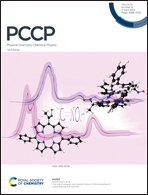DFT insights into competing mechanisms of guaiacol hydrodeoxygenation on a platinum cluster†
Abstract
In a scenario of declining fossil resources and increasing demand for renewable and sustainable alternatives, biomass is the only source able to offer an easy and gradual transition in the use of current energy technologies based on the exploitation of carbon derivatives. Its conversion to liquid fuels has oriented our study towards the computational mechanistic analysis of the guaiacol catalytic hydrodeoxygenation, which is currently considered one of the most challenging routes for upgrading biomass-derived bio-oils. For this purpose, a subnanometric Pt10 platinum cluster was chosen as the catalyst model, with Pt as a computational reference element for catalytic hydrogenation, and guaiacol as a model compound of bio-oils. DFT calculations revealed that the energy barriers related to the cleavage of C(sp2)–O bonds in the direct deoxygenation mechanism are significantly lower (by an average of 60 kJ mol−1) than those in the deoxygenation-through-hydrogenation mechanism in which C(sp3)–O bond breaking from a saturated ring occurs. Even if the ring hydrogenation is easier in the oxygenated compound, the analysis reveals that the direct deoxygenation mechanism is favoured at all temperatures. Furthermore, the results obtained highlight that, from a thermodynamic perspective, the removal of oxygen groups preferentially occurs by the elimination of the –OCH3 fragment as methanol and then of the –OH fragment as a water molecule.



 Please wait while we load your content...
Please wait while we load your content...